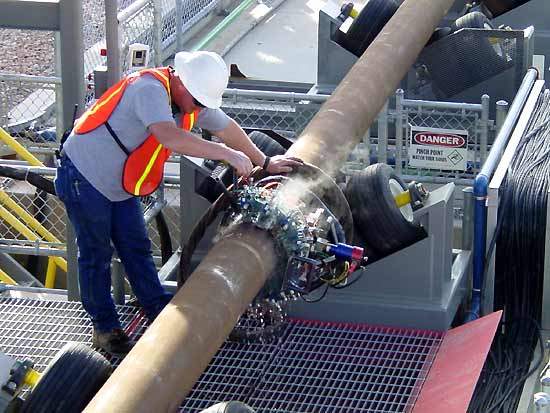Safety First: Comprehensive Pipeline Welding Inspection for Every Project Phase
Safety First: Comprehensive Pipeline Welding Inspection for Every Project Phase
Blog Article
Comprehensive Summary of Pipe Welding Evaluation Treatments
Pipeline welding inspection treatments play a vital function in guaranteeing that bonded connections meet rigorous market standards and requirements. From careful pre-welding assessments to extensive post-weld analyses, a distinct evaluation procedure is necessary for preserving the architectural stability of pipelines.
Pre-welding Examination Preparations
Prior to commencing the welding procedure, extensive pre-welding inspection preparations are vital to make certain the stability and high quality of the weld joint. These preparations involve a careful evaluation of the products to be welded, the welding devices, and the workplace. First of all, the products have to be examined for any kind of problems, pollutants, or inconsistencies that might endanger the weld. This consists of checking for appropriate product qualities, measurements, and surface conditions. Pipeline Welding Inspection. Furthermore, the welding tools requires to be inspected to confirm that it remains in great functioning condition, adjusted correctly, and suitable for the details welding process. Any problems with the tools should be attended to without delay to prevent problems in the weld. Finally, the job setting have to be evaluated for cleanliness, proper ventilation, and precaution to make sure a helpful setting for the welding operation. By conducting complete pre-welding examination prep work, possible problems can be determined and solved beforehand, bring about trustworthy and high-grade weld joints.
Welding Treatment Credentials
Comprehensive pre-welding examination preparations lay the structure for the vital process of Welding Treatment Certification, ensuring the stability and top quality of the weld joint. Welding Procedure Qualification (WPQ) is an important action in the welding process that involves screening and certifying welding treatments to assure they fulfill specific requirements and requirements. The WPQ process usually includes welding treatment spec development, welding treatment credentials testing, and paperwork of the outcomes.
During welding procedure spec growth, vital information such as the welding procedure, welding materials, joint style, and welding specifications are specified to create a detailed treatment. Subsequently, welding procedure credentials screening is conducted to verify the recommended procedure's stability. This screening frequently includes welding examination coupons that undergo various mechanical and non-destructive examinations to assess the weld's quality and adherence to the specified criteria.
In-process Weld Evaluation
During the welding process, in-process weld assessment plays a crucial role in making sure the high quality and stability of the weld joint - Pipeline Welding Inspection. This kind of examination entails checking the welding criteria, analyzing the weld grain development, and detecting any prospective problems or gaps as they happen. By carrying out in-process weld evaluations, welding operators can quickly address any concerns that might develop, consequently stopping additional problems and ensuring that the last weld meets the required specifications
Common approaches utilized for in-process weld inspection include aesthetic evaluation, fluid penetrant testing, magnetic fragment testing, ultrasonic testing, and radiographic screening. Overall, in-process weld assessment is essential for preserving the top quality and reliability of welded pipelines.
Non-destructive Screening (NDT)
Non-destructive Screening (NDT) is a vital approach employed in pipeline welding evaluation to examine the honesty of weld joints without causing damages to the bonded framework. By utilizing various NDT methods, examiners can find more information examine the top quality of welds and identify any problems or interruptions that might compromise the structural sturdiness of the pipeline. Usual NDT approaches utilized in pipe welding evaluation include Radiographic Testing (RT), Ultrasonic Testing (UT), Magnetic Bit Checking (MPT), Fluid Penetrant Screening (LPT), and Visual Screening (VT)
RT includes using X-rays or gamma rays to create my review here photos of the inner framework of the weld, permitting assessors to identify issues such as porosity, splits, or insufficient blend. UT makes use of high-frequency acoustic waves to find imperfections under the surface area of the weld, using thorough info regarding the dimension and place of flaws. MPT and LPT are utilized to determine surface-breaking flaws by using magnetic bits or penetrant fluids to the weld location. Furthermore, VT includes visual evaluation of welds to identify any kind of noticeable flaws.
Post-weld Evaluation and Documents


Documents of post-weld inspection searchings for is essential for maintaining high quality control records and guaranteeing compliance with sector criteria and policies. Detailed reports should include details about the assessment methods utilized, the area and nature of any type of issues found, and any kind of corrective actions taken - Pipeline Welding Inspection. Correct documentation not just works as a record of the weld's top quality however additionally aids in future maintenance and inspection procedures
Final Thought
In conclusion, pipeline welding examination treatments play an essential function in guaranteeing the high quality and integrity of welds. From pre-welding evaluations to post-weld paperwork, each action is click this essential in keeping the security and performance of pipelines. By following well-known procedures and carrying out detailed inspections, possible defects can be recognized and addressed before they result in pricey fixings or failures. In general, adherence to appropriate assessment methods is vital to the success of pipeline welding projects.
From careful pre-welding examinations to thorough post-weld analyses, a distinct assessment procedure is necessary for keeping the architectural strength of pipes. By carrying out in-process weld assessments, welding operators can quickly deal with any type of problems that might emerge, thereby guaranteeing and avoiding additional issues that the last weld meets the called for requirements.
Typical methods made use of for in-process weld assessment include visual examination, liquid penetrant testing, magnetic fragment testing, ultrasonic screening, and radiographic screening.Non-destructive Testing (NDT) is an essential technique employed in pipe welding evaluation to assess the stability of weld joints without triggering damage to the bonded structure. Post-weld assessment involves numerous methods to analyze the welds for problems, consisting of visual inspection, color penetrant screening, magnetic fragment screening, ultrasonic screening, and radiographic testing.
Report this page